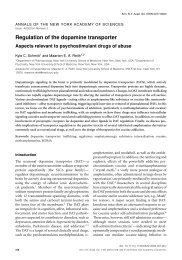The Role of Male Sexual Arousal in Rape: Six Models
The Role of Male Sexual Arousal in Rape: Six Models
The Role of Male Sexual Arousal in Rape: Six Models
You also want an ePaper? Increase the reach of your titles
YUMPU automatically turns print PDFs into web optimized ePapers that Google loves.
628 HOWARD E. BARBAREE AND WILLIAM L. MARSHALL<br />
Stimulus: Emotional<br />
State<br />
<strong>Sexual</strong> Stimulus<br />
<strong>Rape</strong> Stimulus<br />
<strong>Sexual</strong> Stimulus<br />
<strong>Rape</strong> Stimulus<br />
<strong>Sexual</strong> Stimulus<br />
N<br />
E<br />
R<br />
L<br />
v<br />
E<br />
H<br />
E<br />
t<br />
<strong>Arousal</strong><br />
(+)<br />
_ (0)<br />
or<br />
(-)<br />
(+)(+3<br />
_ (-)(-)<br />
<strong>Rape</strong> Stimulus .~_ (+)<br />
Figure4. <strong>The</strong> emotional state augmentation process is illustrated. (In<br />
the upper panel, no augmentation is present. In the middle panel, the<br />
arousal to sexual cues is augmented by positive emotional responses<br />
toward the partner. In the lower panel, the arousal to rape cues is<br />
augmented by negative emotional responses toward the partner.)<br />
possibility that rape arousal is modulated by the emotional<br />
state <strong>of</strong> the subject, or by the nature <strong>of</strong> the emotional response<br />
he directs toward the imag<strong>in</strong>ed victim <strong>of</strong> the rape.<br />
Discussion<br />
Abel et al. (1977) presented data and an <strong>in</strong>terpretation <strong>of</strong> data<br />
that encouraged a sexual preference explanation <strong>of</strong> sexual as-<br />
sault and a sexual preference view <strong>of</strong> rape arousal among rap-<br />
ists. Follow<strong>in</strong>g from this article and view, numerous authors<br />
have espoused the sexual preference hypothesis as it perta<strong>in</strong>s to<br />
rape and violent sexual assault (e.g., Qu<strong>in</strong>sey et al., 1984). This<br />
view would argue that proclivity to rape would be proportional<br />
to the strength <strong>of</strong> sexual arousal to rape cues. However, several<br />
research articles have reported comparisons <strong>of</strong> sexual arousal<br />
to rape cues between rapists and nonrapists <strong>in</strong> which the differ-<br />
ences between these groups are either nonsignificant <strong>in</strong> a statis-<br />
tical sense (Murphy et al., 1984) or unimportant <strong>in</strong> a cl<strong>in</strong>ical<br />
sense (Baxter et al., 1986).<br />
Commentary <strong>in</strong> the literature on these discrepant f<strong>in</strong>d<strong>in</strong>gs<br />
seems, on the whole, to be predicated on the notion that what is<br />
true for one rapist must be true for all others. For example,<br />
when the sexual preference hypothesis has been posited and<br />
supported by research f<strong>in</strong>d<strong>in</strong>gs, it has been discussed as if it<br />
perta<strong>in</strong>s to all, or at least most, sexual aggressors (Abel et al.,<br />
1977; Qu<strong>in</strong>sey, Chapl<strong>in</strong>, & Upfold, 1984). When f<strong>in</strong>d<strong>in</strong>gs have<br />
been expla<strong>in</strong>ed <strong>in</strong> terms <strong>of</strong> a lack <strong>of</strong>dis<strong>in</strong>hibition among rapists<br />
(Barbaree et al., 1979), the explanation has been applied to all<br />
rapists. When authors have been critical <strong>of</strong> the notion that rape<br />
cues have excitatory control over rapists' arousal (Blader &<br />
Marshall, 1989), the criticism has seemed to apply to the use <strong>of</strong><br />
the model for all rapists.<br />
<strong>The</strong> application <strong>of</strong> a s<strong>in</strong>gle model <strong>of</strong> arousal to rapists belies<br />
the data each research group has presented. Exam<strong>in</strong>ation <strong>of</strong><br />
<strong>in</strong>dividual case data will show a heterogeneity <strong>of</strong> pattern <strong>of</strong><br />
response. Even so, a s<strong>in</strong>gle pattern <strong>of</strong> response is <strong>of</strong>ten pre-<br />
sented as be<strong>in</strong>g typical <strong>of</strong> the rapist. For example, even if<br />
groups <strong>of</strong> rapists, on average, show patterns <strong>of</strong> response that are<br />
not different from nonrapists (i.e., that rape cues act to <strong>in</strong>hibit<br />
respond<strong>in</strong>g), it is clear that at least some <strong>in</strong>dividual rapists show<br />
patterns <strong>of</strong> response <strong>in</strong>dicat<strong>in</strong>g that rape cues have excitatory<br />
properties for them (Abel, Blanchard, Baflow, & Mavissaka-<br />
lian, 1975; Barbaree, 1990), or they show a preferential rape<br />
pattern (Freund et al., 1986).<br />
Even <strong>in</strong> studies <strong>of</strong> sexual preferences among child molesters,<br />
where the group studies <strong>in</strong>dicate large differences between<br />
child molesters and normal subjects and where child molesters<br />
as a group show clear evidence <strong>of</strong> a sexual preference for chil-<br />
dren (Freund, 1981; Marshall, Barbaree, & Christophe, 1986;<br />
Qu<strong>in</strong>sey, Ste<strong>in</strong>man, Bergersen, & Holmes, 1975), the pattern <strong>of</strong><br />
respond<strong>in</strong>g has been shown to be extremely heterogenous, with<br />
no less than five different patterns <strong>of</strong> response identified (Bar-<br />
baree & Marshall, 1989).<br />
Knight, Rosenberg, and Schneider (1985) have po<strong>in</strong>ted to the<br />
extreme heterogeneity among sexual <strong>of</strong>fenders measur<strong>in</strong>g dif-<br />
ferences along many different dimensions, <strong>in</strong>clud<strong>in</strong>g sexual<br />
arousal. <strong>The</strong>y go on to argue for the necessity <strong>of</strong> construct<strong>in</strong>g<br />
typologies to describe the heterogeneity that has been ob-<br />
served. Knight and Prentky (1990) have presented a typology <strong>of</strong><br />
rapists that conta<strong>in</strong>s no fewer than n<strong>in</strong>e separate subtypes, and<br />
the typology has been shown to be reliable and to have empiri-<br />
cal validity. <strong>The</strong> possibility exists, and begs <strong>in</strong>vestigation, as to<br />
the relation between patterns <strong>of</strong> response to rape cues and classi-<br />
fication <strong>in</strong> the various rapist subtypes. For example, we might<br />
predict that the sadistic rapists would show evidence <strong>of</strong> rape<br />
cues be<strong>in</strong>g excitatory, <strong>in</strong> comparison with the nonsadistic sub-<br />
type rapists, who may show no such evidence. Perhaps the<br />
model <strong>of</strong> dis<strong>in</strong>hibition <strong>of</strong> rape arousal would account for the<br />
sequence <strong>of</strong> events lead<strong>in</strong>g up to the opportunistic rapist's as-<br />
saults. For the subtypes <strong>of</strong> rapists whose motivation <strong>in</strong>volves<br />
anger and hostility, we might predict that anger would dis<strong>in</strong>hi-<br />
bit arousal to the rape cues <strong>in</strong> the v<strong>in</strong>dictive rapists, and it may<br />
serve to enhance or accelerate arousal <strong>in</strong> the pervasively angry<br />
subtypes.










